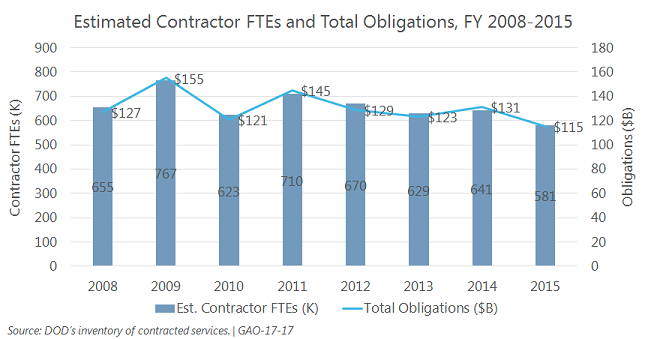DoD Still Struggling to Perform on Contracted Services Inventories
Published: November 10, 2016
IT WorkforceNational Defense Authorization ActPolicy and Legislation
Nearly a decade after Congress began requiring the Department of Defense (DoD) to inventory their contracted services, inconsistencies and incompleteness persist.
As the federal government’s largest purchaser of contractor-provided services, the Department of Defense (DoD) spends tens of billions of dollars on contracted services with companies each fiscal year (FY) and the Congress has wanted the Pentagon to set in place the mechanisms to assess and report the level and cost of what they spend on these contracted services in order to better manage their budget and planning.
In a recent study, the Government Accountability Office (GAO) assessed the extent to which DOD components had reviewed contracts and activities in the fiscal year 2014 inventory of contracted services, and the extent to which they had developed plans to use the inventory for decision making.
As part of the FY 2008 National Defense Authorization Act (NDAA), Congress required DOD to compile and review an annual inventory of its contracted services to identify the number of contractors performing services and the functions contractors performed. DoD was also to ensure that contractors were not performing any inherently governmental functions and to minimize the use of contractors for any activities closely associated with inherently governmental functions. In 2011, Congress required DOD to use that inventory to inform certain decision-making processes, including workforce planning and budgeting.
The DoD reported their estimated number of contractor full-time equivalents (FTE) and total contract obligations on their inventory of contracted services for fiscal years (FY) 2008-2015. While there is a fair amount of variability over the eight-year period contractor FTEs and related contracted services obligations tend to move in tandem, which one would expect to be the case. Further, the trend in both FTEs and obligations has been generally downward over the last five years. (See chart below.)

Improvements and Inadequacies
In the fiscal year 2014 reporting, GAO reported that a total of 40 DoD components certified that they had conducted an inventory review, addressing more of DoD’s required elements compared to prior years, with over half of the components including all six of the required elements, including, for example, identifying any inherently governmental functions and unauthorized personal services contracts.
However, GAO finds that due to inconsistent and incomplete processes and systems – elements that have been addressed by GAO in years past with limited progress shown by many DoD components – the DoD may continue to underreport how often contractors were providing services that are closely associated with inherently governmental functions, a key review objective to help ensure that DOD has proper oversight in place.
For example, GAO says that DoD obligated about $28 billion for contracts across 17 categories that the Office of Federal Procurement Policy (OFPP) and GAO identified as more likely to include activities closely associated with inherently governmental functions. By contrast, DoD components identified a total of $10.8 billion for contracts that included work identified as closely associated with inherently governmental functions, across all categories of service, not just within the 17 categories.
Further, GAO reports that the DoD components have not yet developed plans to use these inventories to inform their workforce mix, strategic workforce planning, and budget decision-making processes, as required by past NDAAs.